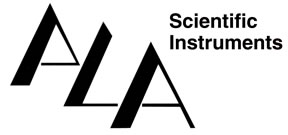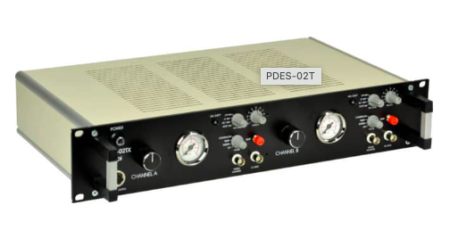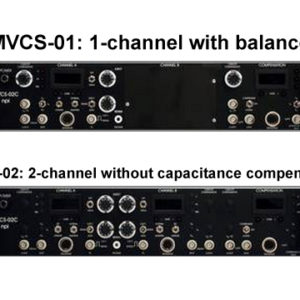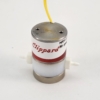Overview
The PDES Pneumatic Drug Ejection System is a device for intracellular microinjection and extracellular dispense of liquids in the picoliter and nanoliter range.
This category of equipment is also known under the generic name “Picospritzer”
Pressure ejection is a convenient method for applying both ionic and non-ionic solutions from micropipettes. First, it can apply to almost all solutions. Second, the amount of the ejected solution can be monitored by viewing the tip of the micropipette under a microscope. npi PDES units are designed for pressure ejection of drugs in physiological and pharmacological studies. PDES systems can are equipped with pressure outputs ( Pmax = 4 bar (58 psi) or 2 bar (29 psi)) for drug application with micropipettes. Digital timers and a remote control unit facilitate the use of these instruments. They are available with one or two application channels. One channel instruments can also be equipped with a retain channel. All PDES units can be operated with internal valves as well as with external valves to reduce the minimal application time to less than one millisecond.
Each channel consists of a precision pressure regulator, pressure display, electronically controlled valves, control electronics, and a regulated power supply. Ejection of drugs can be activated manually or through a TTL input. The operational status is indicated by a red / green LED. Each system is equipped with a monitor BNC connector that reflects the opening time of the pressure valve. In digital systems the pressure is monitored at a BNC connector as well (1 V / bar or 0.1 V / psi).
Last Updated on April 18, 2024
Features
Features:
Last Updated on April 18, 2024
Specifications
| MODE SELECTION |
three position toggle switch, (TIMER, CONT., EXT.). |
| SOURCE GAS |
air, nitrogen, helium etc. no aggressive, combustible or explosive gases, filtered by a 5 µm filter element. |
| PRESSURE RANGE |
input pressure: max. 5 bar (1 bar = 100 kPa = 14.5 psi)
pressure control range: 0-4 bar, 0-58 psi; with microJECT 0-2 bar, 0-30 psi
display range: 0-4 bar, 0-58 psi
residual air pressure: 10 mbar (0.145 psi) – 100 mbar (1.45 psi). |
| INPUT AND OUTPUT COUPLINGS |
quick connect type. |
| DIGITAL TIMER |
100 µs – 9.9 s set by five digit tumble-wheel switch
(0000.1 – 9999.9 ms). |
| VALVE SWITCHING TIME |
15-20 ms (standard valves), <1 ms with microJECT |
| PULSE OUTPUT |
Pressure Monitor: standard BNC connector, sensitivity: 1 V / bar or 0.1 V / psi, output impedance 249 Ω
Timing Monitor: standard BNC connector, TTL (LO = 0-1 V, HI = 5 V), output impedance 249 Ω. |
| PULSE INPUT |
standard BNC connector, TTL (LO = 0-2.5 V, HI = 2.5-5 V), input impedance 10 kΩ. |
| STATUS / EJECT TIME INDICATOR |
red/green LED
red light: channel has been turned on, valve is closed
green light: valve is open. |
| POWER REQUIREMENTS |
115/230 V AC, 20-40 W, |
| DIMENSIONS |
19″ rackmount cabinet, 19″ (483 mm), 10″ (250 mm), 3.5″ (88 mm) |
| REMOTE CONTROL (OPTION) |
Toggle switch and status LED for each channel,
size: 25 x 40 x 100 mm. |
Last Updated on April 18, 2024
Models
Valves – internal or external
With TTL input, the switching time of the valve limits pulse lenght and the time between pulses. The internal and standard external valves have switching times of ~10 ms (i.e. it takes ~10 ms for the valve to open completely and ~10 ms to close completely).
But valve switching times are only one part of the story. The length and diameter of the tubing from the valve to the pipette (i.e. the volume to be set under pressure) largely define the rise time of a pressure pulse at the pipette tip. Therefore the external valve speeds up the system already, although using the same valve (>100 ms with internal valve, >20 ms with external valve).
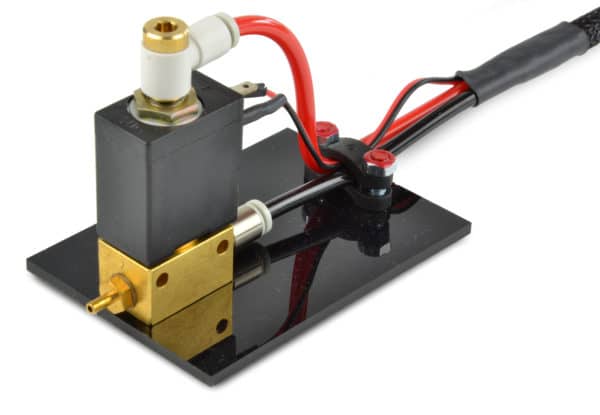
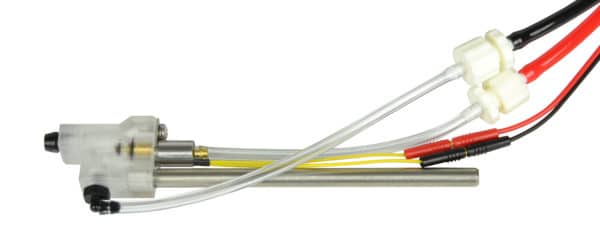
With the fast external valve, the µJECT, this volume is further decreased, since the valve output and the pipette input are in close vicinity (a few mm). With this pulse times of ~2 ms are achievable.
For very local applications (µm range) a fast application is necessary. If you want to do bulk loading, a slower system might be fine for you.
Manometer – digital or analog
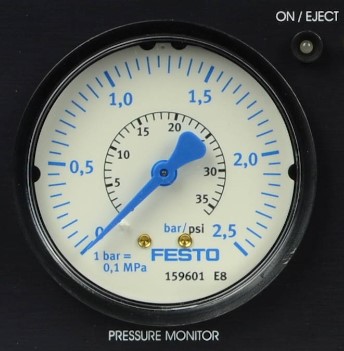
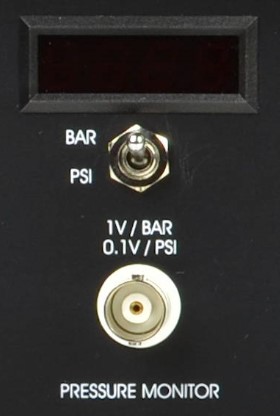
Choosing between the analog and digital manometer is largely a personal preference. While the digital manometer is slightly more expensive than the analog manometer, it offers an additional BNC output where the actual pressure can be monitored e.g. by a data acquisition system.
Last Updated on April 18, 2024
Special
In the PDES-DXH the second channel is replaced by a HOLD channel. This allows application of a small hold pressure in between the application pulses. The hold pressure counter balances the capilarry forces which would otherwise push bath solution from into the pipette.

There are rare cases where a vacuum must be applied in order to prevent application liquid from exiting the pipette. A very convenient way to do so is the use of ALA’s 2PK+ presssure/vacuum controller.
Last Updated on April 18, 2024
Downloads
Last Updated on April 18, 2024
References
Imaging of Local and Global Sodium Signals in Astrocytes
Thin graphene oxide nanoflakes modulate glutamatergic synapses in the amygdala cultured circuits: Exploiting synaptic approaches to anxiety disorders
Panglial gap junctions between astrocytes and olfactory ensheathing cells mediate transmission of Ca2+ transients and neurovascular coupling
Fischer, A.U., Müller, N.I.C., Deller, T., Del Turco, D., Fisch, J.O., Griesemer, D., Kattler, K., Maraslioglu, A., Roemer, V., Xu‐Friedman, M.A., Walter, J. and Friauf, E. (2019), GABA is a modulator, rather than a classical transmitter, in the medial nucleus of the trapezoid body–lateral superior olive sound localization circuit. J Physiol, 597: 2269-2295. doi:10.1113/JP277566
Polymer microchamber arrays for geometry-controlled drug release: a functional study in human cells of neuronal phenotype
Ansorge, J., Humanes‐Valera, D., Pauzin, F.P., Schwarz, M.K. and Krieger, P. (2020), Cortical layer 6 control of sensory responses in higher‐order thalamus. J Physiol. doi:10.1113/JP279915
Last Updated on April 18, 2024
Ordering
We offer a fully configured system as a set, including all necessary accessories. With this system you can cover most of the application scenarios:
PDES-SET-01 with one channel, including connection tubing, external valve and injection pipette holder
| PDES-SET-01 |
| PDES-01DE-4 |
One channel with external valve, digital timer, analog pressure gauge |
| PDES-01-BOX |
External valve with magnetic base for easy attachment to table, microscope, rack cabinet, etc.
Comes with flexible tubing for pipette/pipette holder |
| PDES-EH |
Injection pipette holder |
| PDES-T-6 |
Tubing from pressure source to PDES |
|
Tube/hose cutter tool for adjusting tubing lengths |
PDES-SET-02 with two individual channels, including connection tubing, external valves and injection pipette holders
| PDES-SET-02 |
| PDES-02DE-4 |
Two channels with external valve, digital timer, analog pressure gauge |
| PDES-02-BOX |
External valves with magnetic base for easy attachment to table, microscope, rack cabinet, etc.
Comes with flexible tubing for pipette/pipette holder |
| PDES-EH |
Injection pipette holder |
| PDES-T-6 |
Tubing from pressure source to PDES |
|
Tube/hose cutter tool for adjusting tubing lengths |
The various configurations of PDES systems are reflected in the part number
PDES-0X-(U)Y(E)-M-LA-Z
where:
X = number of channels (1 or 2)
U = upgrade
Y = type of timer (D=digital)
E = configuration with external valve(s), blank = configuration with internal valve(s)
M = module
LA = configuration with digital display(s), blank = configuration with analog display(s)
Z = maximum pressure (2 bar [29 psi] or 4 bar [58 psi])
External valve options:
- PDES-0X-BOX (for standard valves [20 ms and longer])
where:
X = number of channels (1 or 2)
- PDES-EHM (for microJECT valves [2 ms and longer])
for one channel
Last Updated on April 18, 2024
